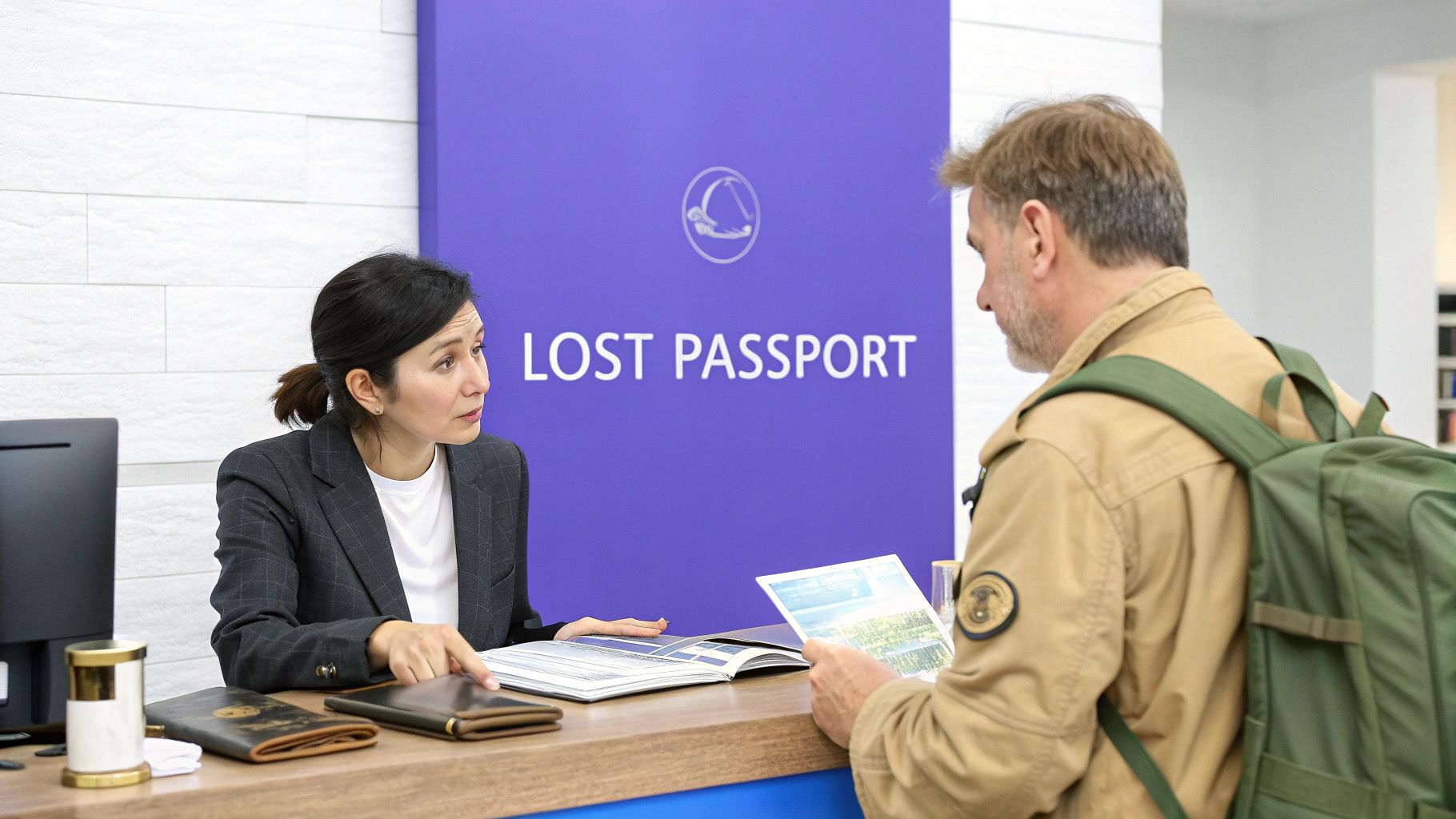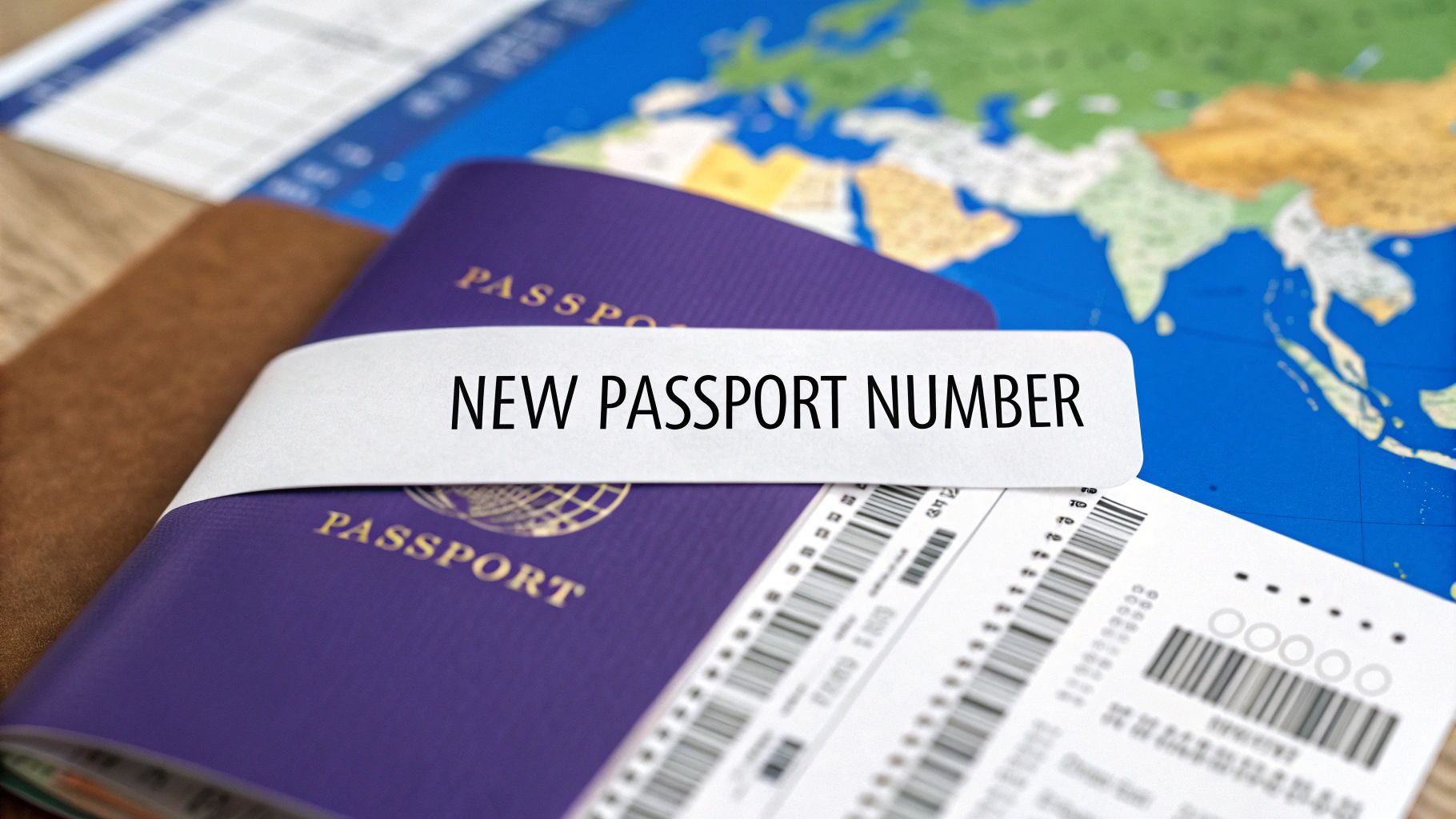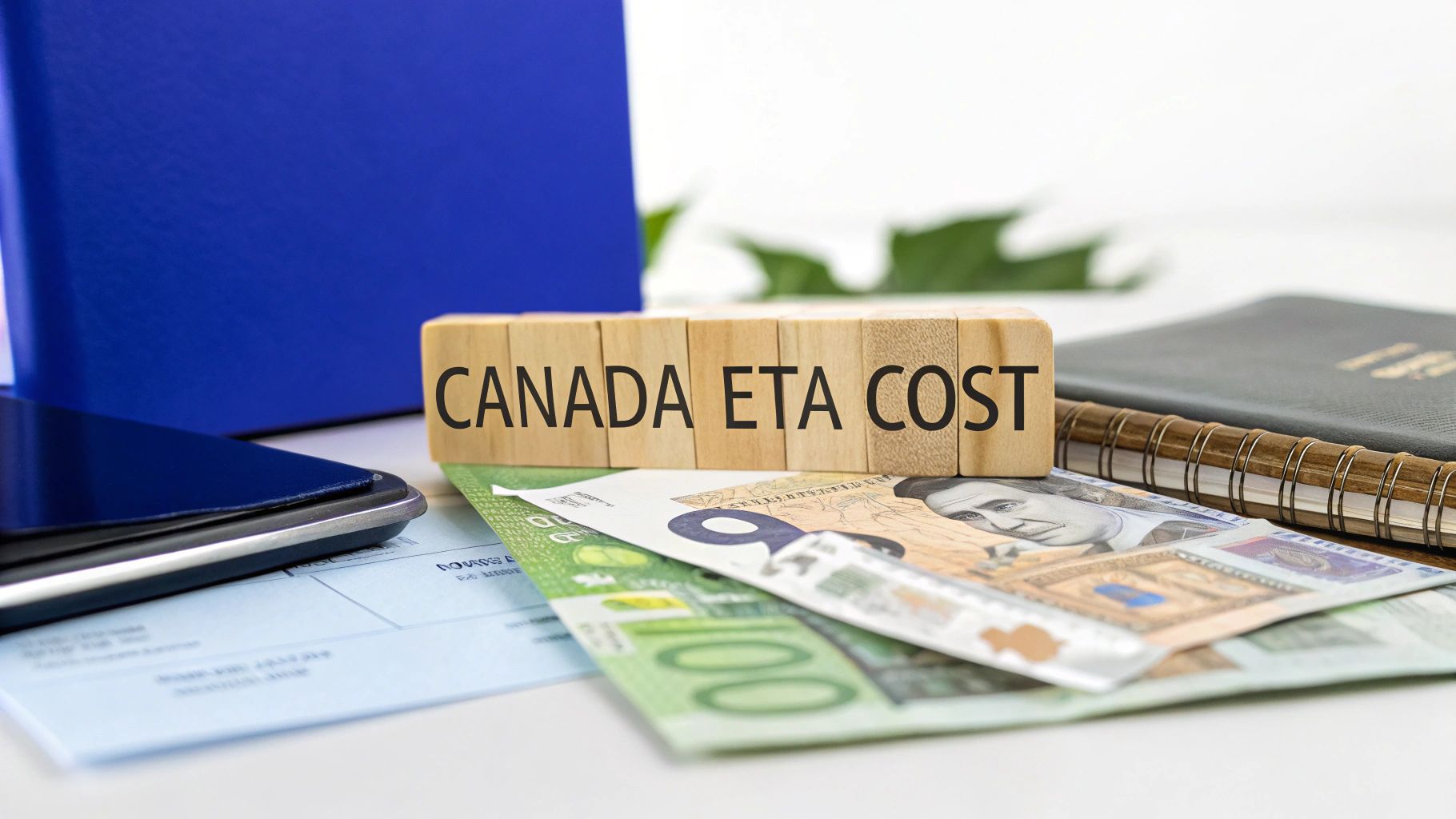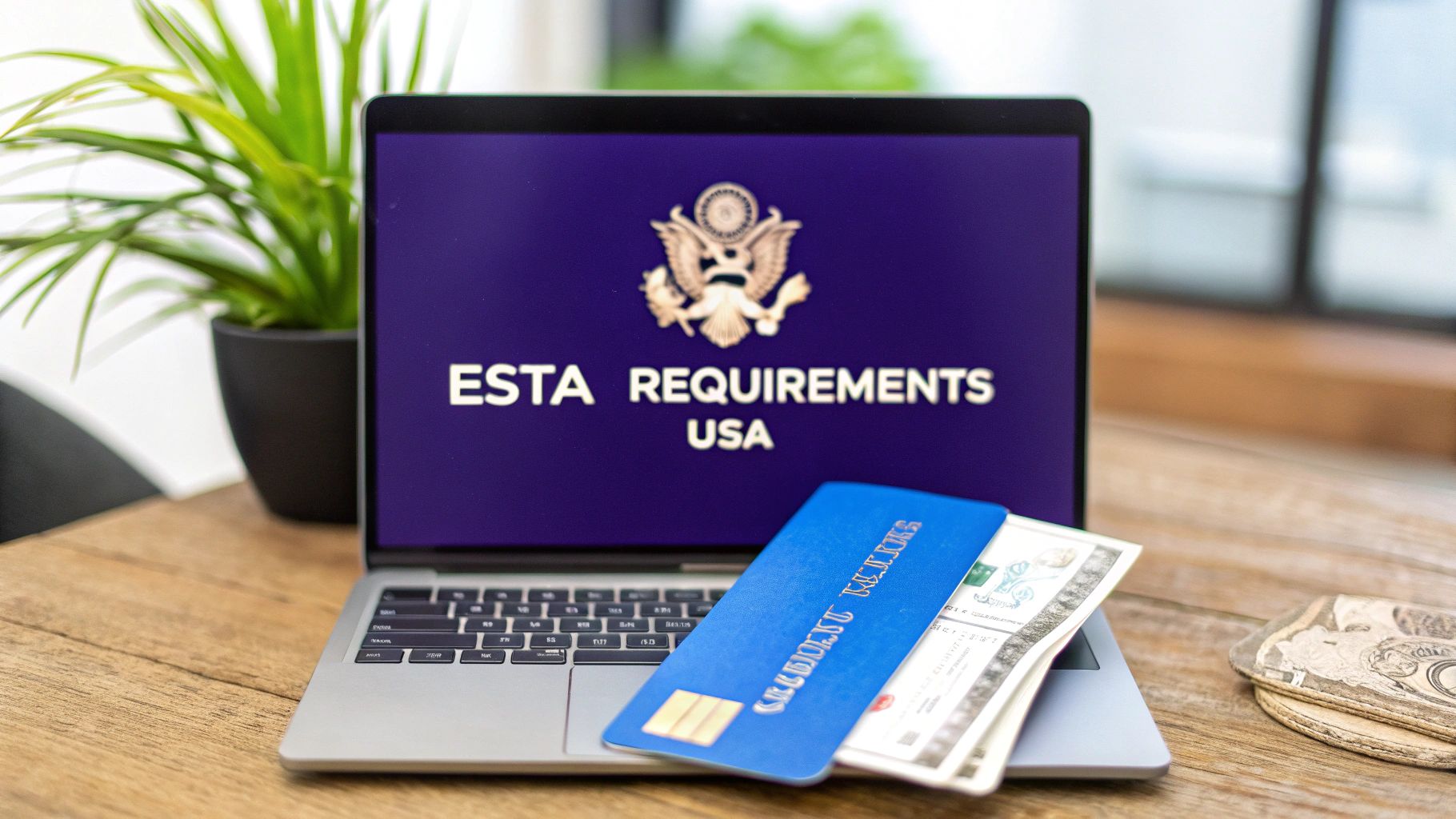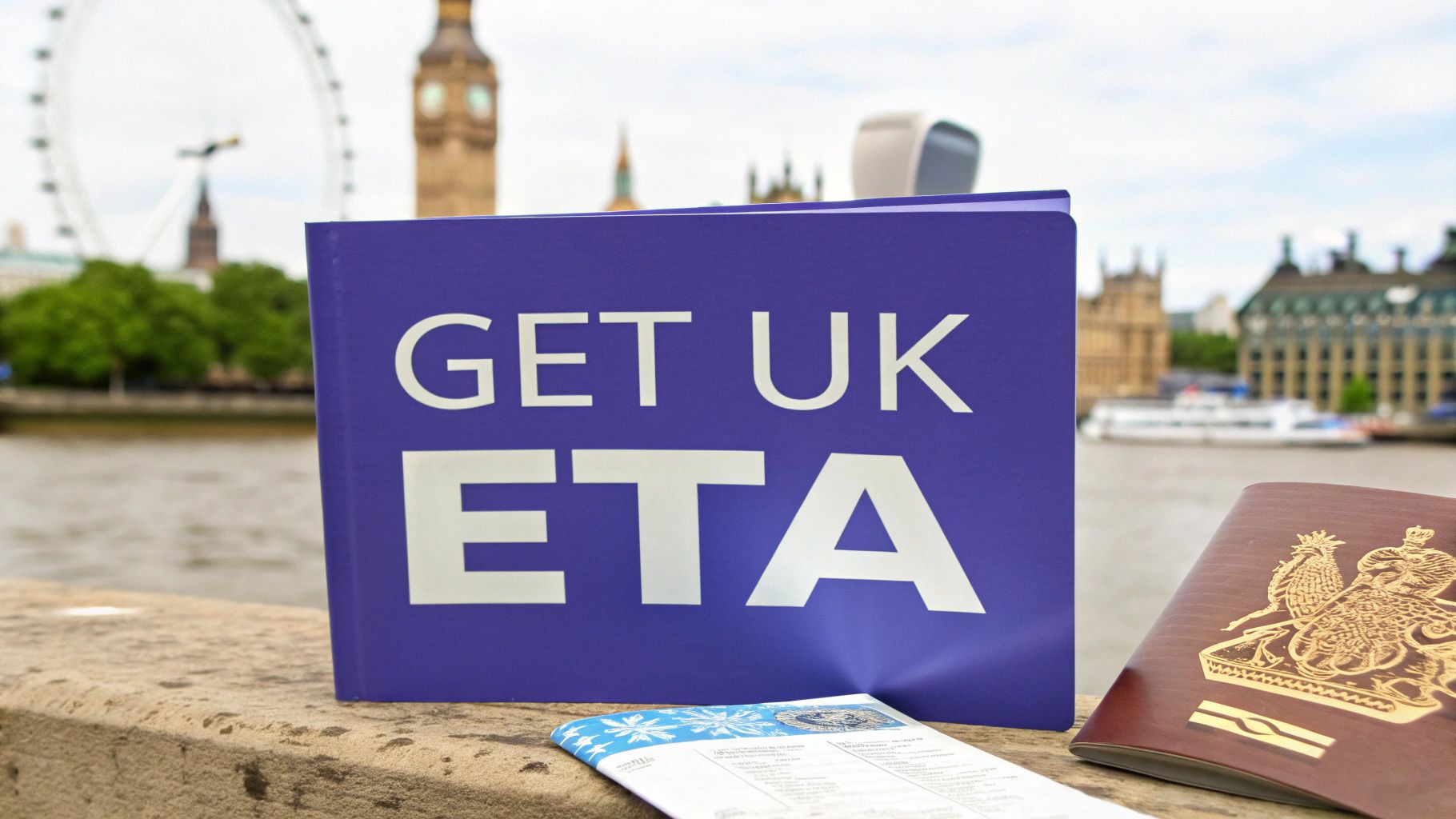
UK Transit Visa Requirements: A Complete Guide
Working out your UK transit visa requirements really boils down to one simple question: will you be staying 'airside' in the airport's international zone, or will you need to pass through UK border control ('landside')? The answer almost always depends on your passport and the nitty-gritty details of your connection, like whether you’re changing airports or have a long layover.
Getting this part right from the start is the key to figuring out exactly what you need to do.
Understanding the UK Transit Maze
Planning a trip that includes a stopover in the UK can feel like a headache waiting to happen. The rules can seem complicated, but they start to make perfect sense once you grasp the two main ways you can transit: ‘airside’ and ‘landside’. This single distinction is the foundation for everything that follows.
Airside vs. Landside Transit: What's the Difference?
Think of 'airside' transit as using a special corridor for international passengers. You arrive from another country and head straight to your next flight without ever officially entering the UK. You're simply moving between gates within the airport's secure transit lounge. This is usually an option only if you meet a few conditions:
- You're flying into and out of the same UK airport (e.g., London Heathrow).
- Your connecting flight is on the same day, and you don't need to collect your luggage and check it in again.
- Your nationality allows you to transit without a visa.
‘Landside’ transit, on the other hand, means you must pass through UK border control. It's like getting a very brief, temporary pass to enter the country before you leave again. You'd have to go landside if your travel plans involve:
- Changing airports (like arriving at Gatwick and flying out of Heathrow).
- Collecting your bags to check them onto your next flight.
- An overnight layover where you plan to leave the airport and stay in a hotel.
Your Nationality is the Next Big Factor
The next piece of the puzzle is your passport. The UK government sorts travelers into two main camps: those who typically need a visa to enter the UK (‘visa nationals’) and those who don’t. Which group you belong to has a huge impact on your transit requirements.
If you hold a passport from a country on the UK's 'visa national' list, you'll almost certainly need some form of permission to transit through the UK. Even if you're staying airside for just a couple of hours, you'll likely need a Direct Airside Transit Visa (DATV) unless you qualify for a rare exemption. If you have to go landside, the rules get even stricter—you'll generally need a Visitor in Transit visa.
This simple decision tree can help you see where you stand based on your passport and travel plans.
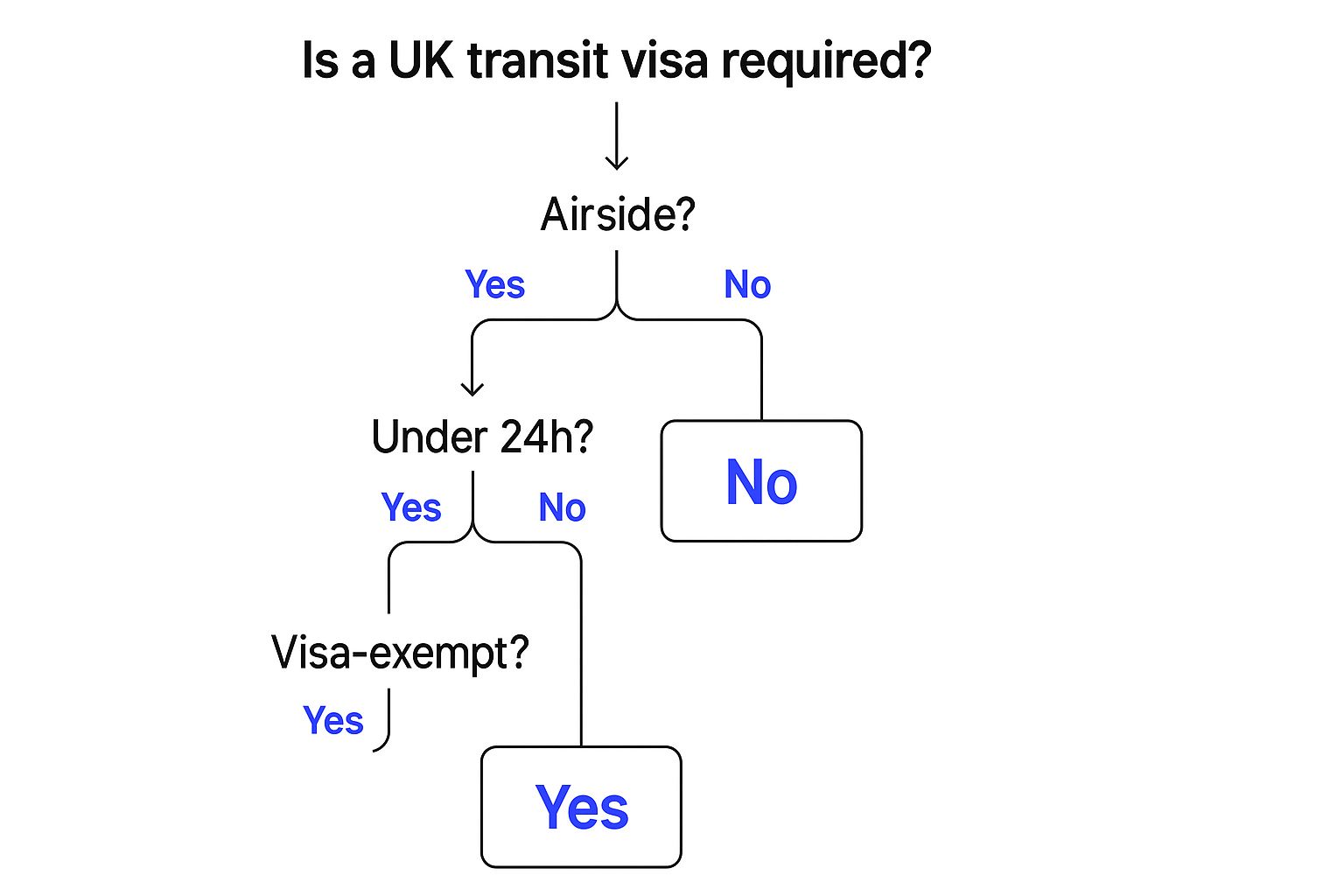
As you can see, it's the mix of your nationality and whether you cross the border that truly determines what you need to do next.
To make things even clearer, let's break down the common scenarios.
Quick Guide to UK Transit Requirements
Use this quick guide to get a snapshot of what you'll probably need based on your situation.
| Your Travel Scenario | What You Likely Need | Key Factor to Consider |
|---|---|---|
| I'm staying in the same airport, and I don't need to pass border control (airside). | You might be exempt or need a Direct Airside Transit Visa (DATV). | Your nationality is the deciding factor. Many nationalities are exempt. |
| I need to pass border control to change airports or collect my bags (landside). | You might need a Visitor in Transit visa or the new UK ETA. | Your layover must be less than 48 hours. |
| I'm from a country eligible for the new Electronic Travel Authorisation (ETA). | A UK ETA will cover your transit. | This new system simplifies the process for eligible nationalities. |
This table is just a starting point, of course. Always double-check the official requirements for your specific passport and itinerary on the GOV.UK website.
The UK ETA: A New, Simpler Route for Some Travellers
For citizens of certain countries, the new Electronic Travel Authorisation (ETA) system is a real game-changer. If you’re from an ETA-eligible nation, this digital permit is all you need to transit through the UK, making the whole process much more straightforward. The travel authorization for UK transit acts as your pre-approved permission to travel.
To simplify your ETA application and increase your chances of approval, consider using AssistEntry — their experts guide you through the entire process, starting from just $79.
Using a third-party application assistance provider like AssistEntry helps you avoid delays and mistakes. Their service includes full verification of your UK ETA application, error-checking, and a compliance review, which greatly increases your chances of approval due to their expert handling. It’s a great way to ensure your journey through the UK is as smooth as possible.
Airside vs. Landside: Understanding Your Transit Path

The single most critical factor that shapes your UK transit visa requirements is your path through the airport. Will you stay 'airside,' or will you need to go 'landside'? Getting this right isn't just a minor detail—it's the key that dictates the permission you need and can save you from a world of travel headaches.
Think of it like this: your journey through a UK airport can take one of two completely different routes, each with its own set of rules. Nailing this distinction from the start is your first step toward a smooth, stress-free connection.
The Airside Path: The International Corridor
Staying airside means you technically never set foot in the United Kingdom. Picture it as a secure international corridor tucked inside the airport. You get off your plane, follow the signs for "International Flight Connections," and head straight to your next gate without ever seeing a UK passport control officer.
It's the simplest way to transit, but it only works if your trip meets a few strict conditions:
- Single Airport: You must arrive and depart from the same UK airport.
- Checked-Through Luggage: Your airline has to check your bags all the way to your final destination.
- Same-Day Connection: Your onward flight has to leave on the same calendar day you arrive.
If your nationality requires a visa for this path, you'll need a Direct Airside Transit Visa (DATV). Think of the DATV as a special ‘hall pass’ that grants you access only to the airport's international departure lounge. You absolutely cannot leave the airport with it.
The Landside Journey: A Temporary UK Entry
Going landside, on the other hand, means you have to pass through UK Border Control, officially entering the country for a very short time. This becomes necessary in several common travel scenarios where staying in the international zone just isn't an option.
You'll have to go landside if you:
- Change Airports: For instance, arriving at London Heathrow (LHR) and having to catch your next flight from London Gatwick (LGW).
- Collect and Re-Check Luggage: If you're flying on separate tickets or with airlines that don't partner for baggage, you'll have to grab your bags and check them in all over again.
- Have an Overnight Layover: Planning to leave the airport for a hotel? That's a landside journey.
- Face a Long Connection: Some airports shut down their airside transit areas overnight, forcing all connecting passengers to go landside.
For these situations, travellers from visa-required countries need a Visitor in Transit visa. This one is more like a ‘24-hour entry ticket’ to the UK. It gives you permission to cross the border and stay for up to 48 hours before you must catch your connecting flight.
Key Takeaway: The decision between airside and landside transit isn't up to you—it’s dictated by your flight itinerary and baggage arrangements. Always, always confirm these details with your airline before you book.
For some travellers, especially those from ETA-eligible nations, the new Electronic Travel Authorisation for UK has made things much simpler. A UK ETA covers both airside and landside transit, meaning you likely won't need a traditional visa at all. Knowing the process is just as vital as having the right document, which is why we put together a guide on what to expect at the UK border with an ETA.
Ultimately, figuring out whether your path is airside or landside is the foundation of a successful UK transit. It ensures you apply for the right permission and avoid costly delays or, worse, being refused entry.
Your Essential UK Transit Visa Document Checklist
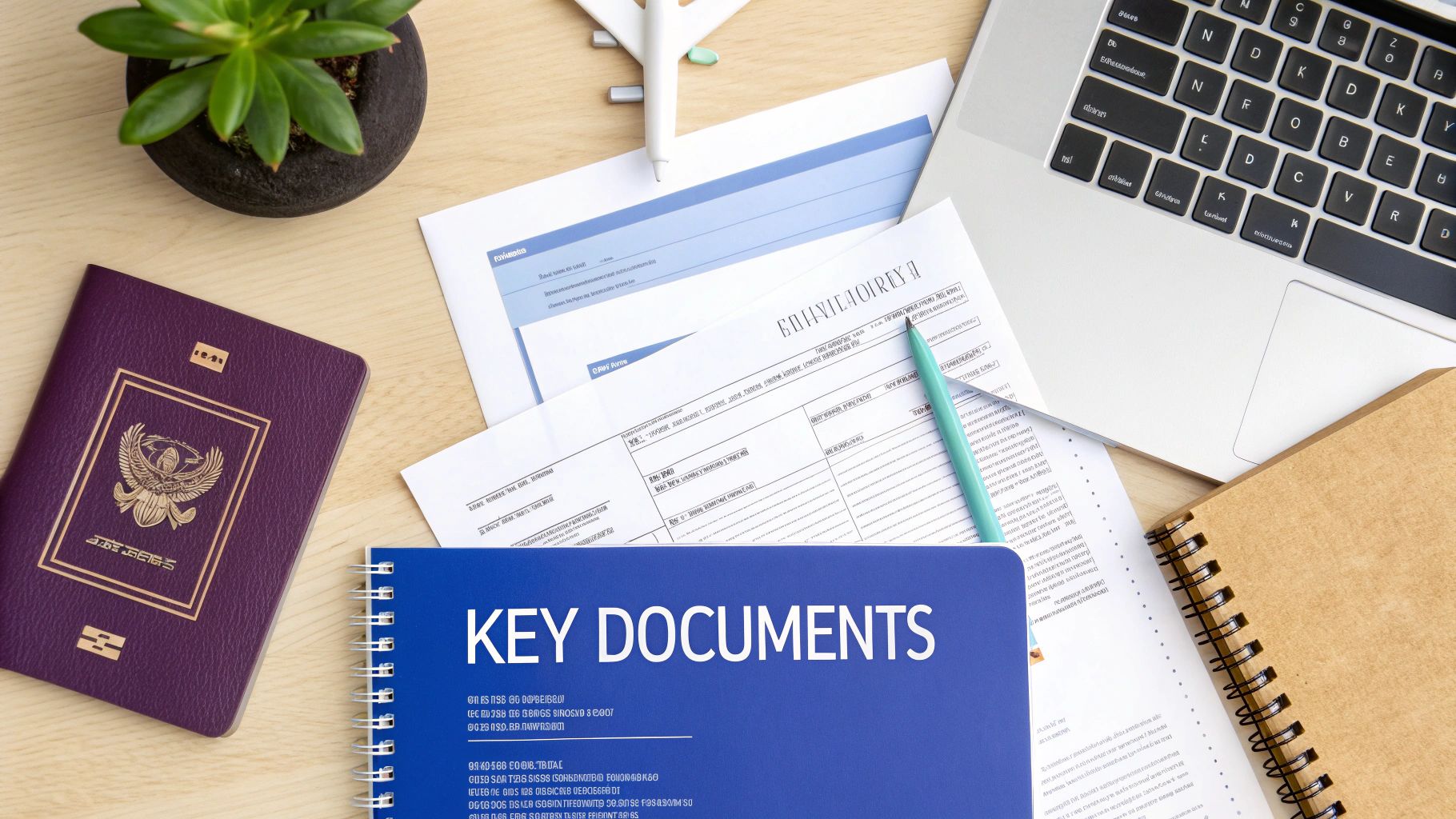
Getting a UK transit visa application right feels a lot like packing for a tricky expedition. You need a checklist, but more importantly, you need to know why each item is on that list. Every document you provide helps tell the UK Home Office a clear, simple story: you're just passing through and have a solid plan to get to your final destination.
A messy application with missing pieces or confusing information sends up immediate red flags. Let’s walk through exactly what you need to build a rock-solid case that leaves no room for doubt.
Core Documents Everyone Needs
Think of these as your absolute must-haves, the non-negotiables for any transit visa application, whether it's a Direct Airside Transit Visa (DATV) or a Visitor in Transit visa.
- A Valid Passport or Travel Document: This is your ID. It has to be valid for your entire journey and must have at least one completely blank page for the visa sticker. Submitting a passport that's expired or about to expire is one of the fastest ways to get a rejection.
- The Completed Online Application Form: This is your official statement. Double and triple-check everything for accuracy. A tiny typo or a date that doesn't match your flight tickets can create major problems.
- One Passport-Sized Colour Photograph: The UK has very specific rules for visa photos, covering everything from the background colour to your facial expression. Make sure your photo ticks every single box.
Proving You Are a Genuine Transit Passenger
This is where you really make or break your application. Your goal is to show the visa officer, with concrete evidence, that you have a fully planned and booked journey that just happens to pass through the UK.
You’ll need to prove two key things:
- Proof of Your Onward Journey: A simple reservation won't cut it. You need a confirmed booking for your flight, train, or ferry leaving the UK. Ideally, this should show you departing within 48 hours of your arrival.
- Permission to Enter Your Final Destination: You must prove you're allowed into the country you're ultimately heading to. This could be a visa for that country, a residence permit, or simply proof of your citizenship there.
Here's a real-world example: Say you're an Indian citizen flying to Canada for a vacation, with a layover in London. You'd need to show your confirmed flight ticket from London to Toronto and your valid Canadian tourist visa. This simple combination proves to the officer that you have a legitimate, approved destination waiting for you.
Gathering the right paperwork is critical, especially when you see how few of these visas are issued. In the year ending March 2025, the UK granted just 17,349 transit visas—a drop in the ocean compared to other visa categories. This tells you the screening process is tough, so your application has to be flawless.
Demonstrating Financial Stability
You also need to show you can cover your own costs during your short stop in the UK without relying on public funds. This is especially true for the Visitor in Transit visa, which lets you leave the airport.
You can prove this with things like:
- Recent bank statements showing a healthy and stable balance.
- Payslips from your current job.
- A letter from a sponsor clearly stating they will cover your costs.
For many travellers, the game has changed with the new Electronic Travel Authorisation (ETA) system. If you're from an eligible country, an ETA can cover you for transit, but even small mistakes on the form can cause a denial. Our guide to the UK ETA application is a fantastic resource for navigating that process smoothly.
How to Apply for Your UK Transit Visa Step by Step
Navigating the UK's official visa application can feel like you're trying to solve a puzzle in the dark. It’s a maze of forms, appointments, and very specific rules. But if you break it down, it’s just a series of steps. Let's walk through the whole process together, from the first click on the application form to your biometrics appointment, so you can apply with total confidence.
Your journey starts and ends on one website: the official GOV.UK portal. This is the only legitimate place to apply for a Direct Airside Transit Visa (DATV) or a Visitor in Transit visa. You'll likely see other sites that look official, but don't be fooled—stick to the genuine government portal.
The Online Application Form
First things first: you have to tackle the online application form. Accuracy is everything here. Every single detail, from your name and birthdate to your flight numbers, has to be a perfect match with your passport and other documents.
Think of this form as your formal introduction to the UK Home Office. A tiny typo in your passport number or a mistake in your travel dates could lead to serious delays or even a flat-out rejection. So, take a deep breath, read every question twice, and have all your documents laid out in front of you before you even start typing. You’ll need to share your travel history, your full UK transit itinerary, and solid proof that you're allowed to enter your final destination.
Paying the Fee and Booking Your Biometrics Appointment
After you’ve triple-checked and submitted your online form, you'll be directed to pay the application fee. The exact cost depends on which transit visa you're applying for. Keep in mind, this fee is non-refundable, even if your application gets denied, so it pays to be certain you're eligible before you part with your cash.
Once payment is confirmed, you'll move on to the next critical step: booking an appointment at a Visa Application Centre (VAC). This is where you'll give your biometric information—your fingerprints and a digital photo. These centers are run by official partners of the UK government and are located all over the world. You'll just need to pick the one most convenient for you and lock in a date and time.
Insider Tip: VAC appointments can get booked up weeks or even months in advance, especially during popular travel times. Book your slot the moment you submit your form to avoid a last-minute scramble that could put your entire trip at risk.
What to Expect at the Visa Application Centre
The appointment itself is pretty straightforward, but it’s a formal process. You absolutely must bring your current passport, a printed copy of your application form, and every single supporting document you mentioned. An official will go through your paperwork to make sure it's all there before they take your photo and scan your fingerprints.
While this guide focuses on the traditional visa route, it’s good to know that things are changing. The UK is rolling out a new Electronic Travel Authorisation (ETA) system, which is a game-changer for eligible nationalities. If you qualify, knowing how to apply for a UK ETA offers a much simpler and faster alternative to the full visa process.
Avoiding Common Pitfalls and Ensuring Success
So, what trips most people up? In my experience, it's almost always incomplete or inconsistent information. You have to be meticulous. Make sure your bank statements clearly show you have enough money for your trip, that your flight bookings are fully confirmed (not just reserved), and that your visa or entry permit for your final destination is undeniable.
By following these steps methodically, you can transform what seems like a bureaucratic headache into a simple checklist. Prepare everything thoroughly and obsess over the details—that’s your best strategy for a smooth and successful UK transit visa application.
Who Can Transit the UK Without a Visa?
Working out whether you need a UK transit visa can feel a bit like decoding a puzzle, but there’s some good news. A surprising number of travelers can actually pass through the UK without needing a transit visa at all. It’s an official exemption called the ‘transit without visa’ concession, and it could save you a lot of hassle and money.
Don't assume that just because your nationality normally requires a UK visa, you automatically need one for transit. If you're holding certain other travel documents, you might be in the clear. This applies whether you're staying airside (never passing through UK border control) or going landside (entering the UK for a short period to catch your next flight).
The 'Transit Without Visa' Exemption Explained
So, what is this powerful exemption? Essentially, it lets travelers who would typically need a transit visa to pass through the UK if they already hold a valid visa or residence permit from a select group of countries. Think of it as the UK piggybacking on the security and background checks already done by its trusted international partners.
Here are the most common documents that will get you through under this scheme:
- A valid visa for Australia, Canada, New Zealand, or the USA. It doesn’t matter if it’s a tourist, work, or student visa.
- A valid permanent residence permit issued by Australia, New Zealand, or Canada (must be issued after 28 June 2002).
- A common format residence permit from a country in the EEA (European Economic Area) or Switzerland.
- A uniform format category D visa allowing entry into an EEA country or Switzerland.
Strict Conditions You Must Meet
Holding one of these documents is the first hurdle, but it’s not the only one. To qualify for the 'transit without visa' scheme, your travel plans have to meet a very specific set of conditions. The UK government needs to be absolutely certain you're a genuine passenger just passing through.
The main rule is that you must be on a reasonable and logical journey. This means you need to tick all of these boxes:
- You must arrive by plane and have a confirmed ticket for a flight leaving the UK.
- Your connecting flight must leave on the same day you arrive or, at the latest, before midnight on the day after your arrival.
- You must have all the necessary documents for your final destination, like a visa if one is required.
Crucial Point: Your journey has to make sense. Flying from India to the USA via London with a valid US visa? That's a perfectly reasonable route. But flying from India to Dubai via London just because you have a US visa? That would likely raise red flags, as it's not a logical part of a trip to or from the United States.
Navigating the New UK ETA System
The travel rules for the UK are also shifting with the introduction of the new Electronic Travel Authorization for UK. For travelers from certain countries, especially those in the Gulf Cooperation Council (GCC) and Jordan, the ETA is replacing the need for visas for short visits, including transit.
If you are from an ETA-eligible country, the system is designed to cover your transit needs, meaning you won't have to apply for a separate transit visa. To get the full picture, our detailed guide explains what the UK ETA is and how it works. This new digital system makes the whole process much simpler.
The UK ETA: A Simpler Way to Transit
For many travelers, the new UK Electronic Travel Authorisation (ETA) system is a total game-changer, especially for those just passing through. Think of it as a digital pass that, for many nationalities, gets rid of the need for a full-blown transit visa. The whole point is to make your journey smoother, quicker, and more secure.
The great thing about the ETA is its flexibility. It works for both airside transit (where you stay in the international departures area) and landside transit (where you need to pass through border control to, say, catch a connecting flight from a different airport or re-check your bags). If you're eligible, one approved ETA has you covered for either scenario.
Getting Your ETA Application Right
Now, while the ETA is much simpler than a traditional visa, you can't just wing the application. It demands real attention to detail. I’ve seen travel plans thrown into chaos over tiny mistakes—a single digit off in a passport number or a mistyped date of birth can lead to a surprise rejection. It's critical to answer every question with complete accuracy.
To sidestep these common headaches, a lot of travelers find that using a trusted third-party application assistance provider is a smart move.
For a totally seamless application, it’s worth considering a specialized service. Their experts can spot potential errors before they become a real problem, which seriously boosts your approval chances and gives you some much-needed peace of mind.
This is what a clear, user-friendly application portal from a dedicated service like AssistEntry looks like.
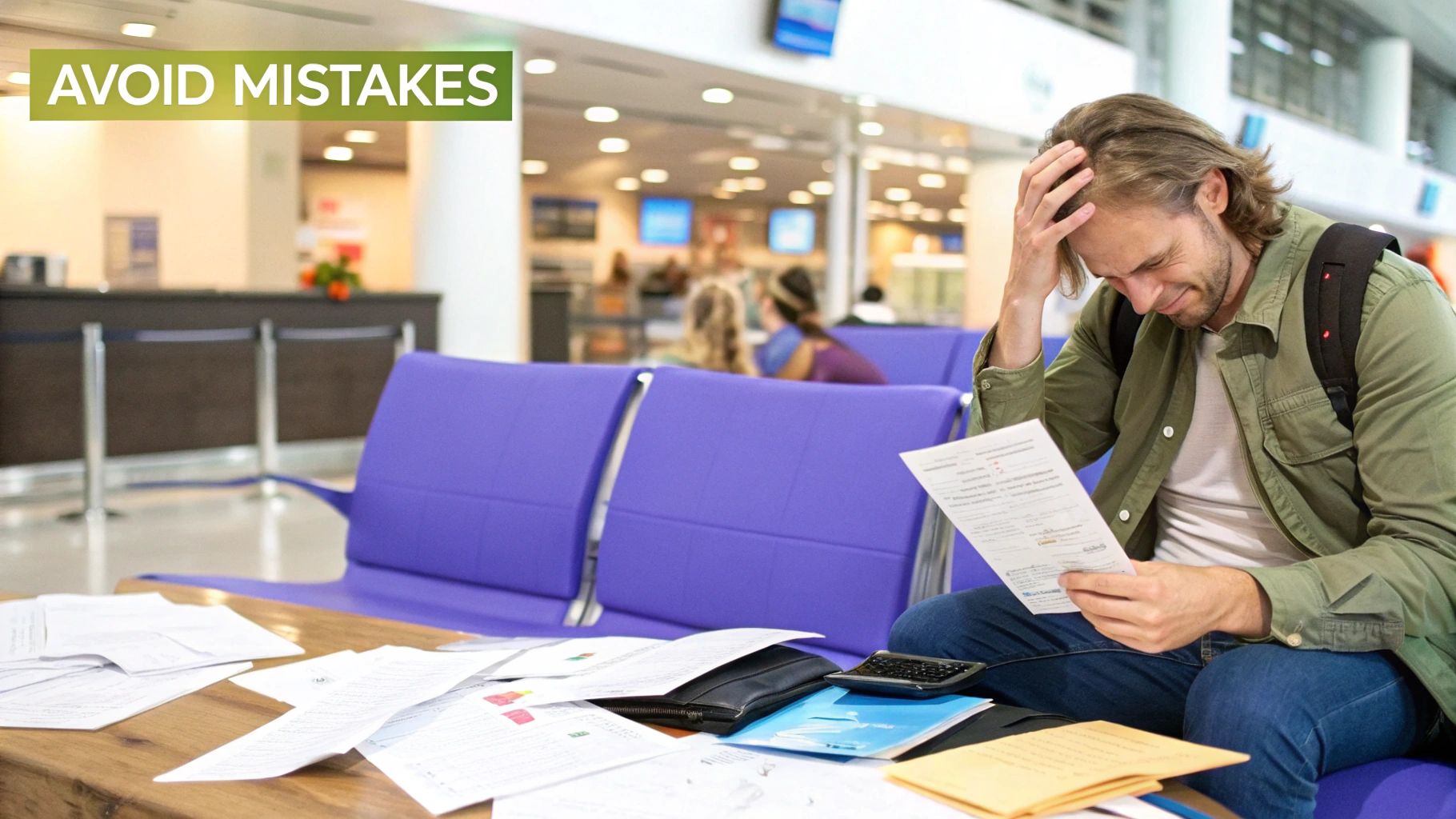
The clean layout walks you through the process step-by-step, making sure you don't miss a thing. It's this kind of structured approach that helps prevent the simple slip-ups that often cause delays on government websites.
Why Bother With a Third-Party Service?
Let's be honest, applying for any kind of travel document can be a bit of a nail-biter. But it doesn’t have to be. When you choose an expert assistance provider, you're essentially buying a stress-free experience. These services are built to catch the common mistakes that get applications denied.
For a fee starting from $79 (it include government fee, all cost included), you’re getting more than just someone to click "submit" for you. Your UK ETA application gets a thorough review by a team of actual experts.
Here’s a breakdown of what that gets you:
- Full verification of the application before submission: Your application is checked from top to bottom for accuracy and completeness before it even goes to the UK authorities.
- Error-checking and compliance review: Experts double-check your information against all the strict requirements, catching any typos or inconsistencies.
- Increased chances of approval due to expert handling: An error-free, fully compliant application stands a much, much higher chance of getting approved without a hitch.
To make getting your travel authorization for UK transit as simple as possible and give yourself the best shot at success, getting some expert help is a no-brainer. You can also dig deeper into how the ETA works for specific nationalities in our guide on the UK ETA for US citizens.
Right, let's tackle some of the most common questions that pop up when you're trying to figure out UK transit rules. Getting these details straight can be the difference between a smooth connection and a major headache.
How Long Can I Stay on a Visitor in Transit Visa?
Think of the Visitor in Transit visa as a ticket for a very short stopover. It gives you a maximum of 48 hours in the UK. The key here is proving you have a solid plan to leave within that window—your confirmed onward flight is non-negotiable.
This is worlds apart from a Direct Airside Transit Visa (DATV). With a DATV, you're essentially locked in the international zone of the airport. You can't pass through UK border control, period.
What Happens if a Flight Delay Messes Up My Transit Time?
We’ve all been there—the dreaded flight delay. If a delay throws your connection into chaos, your first call should always be to the airline. They're on the front line and will have the most immediate information.
Now, if you only have a DATV and the delay means you suddenly need to go through border control (maybe to check into a nearby hotel for the night), you'll have to speak directly with the UK Border Force officials at the airport. They handle these situations case-by-case. This is one of those moments where having a Visitor in Transit visa gives you a lot more breathing room.
Can I Use AssistEntry for a Regular UK Transit Visa?
This is a great question we get a lot. AssistEntry.com is a trusted application assistance provider, but they are specialists in one thing: the UK Electronic Travel Authorisation (ETA) system. They're fantastic for travelers who are eligible for an ETA.
However, they don't handle the more traditional visa applications, like the DATV or the Visitor in Transit visa. For those, you have to go through the official UK government portal. So, if you're from an ETA-eligible country, the UK ETA is by far your simplest path for transit.
To simplify your UK ETA application and increase your chances of approval, consider using AssistEntry — their experts guide you through the entire process, starting from just $79. Get your UK ETA with expert help today.
